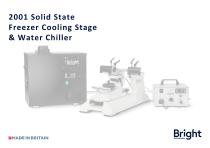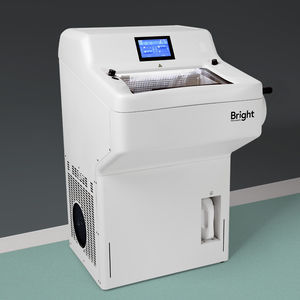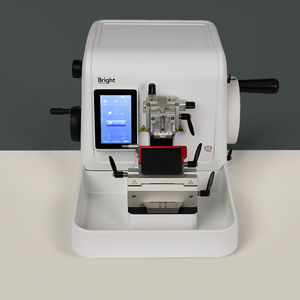
- Products
- Bright Instruments

- Company
- Products
- Catalogs
- News & Trends
- Exhibitions
Microtome cooling module 2001

Add to favorites
Compare this product
Characteristics
- Applications
- for microtomes
Description
For some sectioning work it is necessary to cool a specimen below room temperature. The Bright Solid State Freezer incorporates a Peltier device cooling stage and will permit specimen cooling from ambient to -25°C or lower, depending on conditions.
The equipment consists of a control unit and a cooling stage, the cooling stage being available in two sizes – 30mm x 30mm or 40mm x 40mm. Primarily designed for use with the Bright 5040 rotary and the Bright 8000 base sledge microtomes, the Solid State Freezer may be used with other rotary and sledge microtomes.
Specimen Holder
The Solid State Freezer fits to the microtome in place of the normal specimen holder. It has a water inlet, a water outlet and an electrical connection to the control unit. The control unit permits temperature control but does not measure temperature directly, instead a reading of the current passed to the Peltier device is indicated on the front panel. The control unit also has a built in safety device, which detects low water flow. After sectioning, the specimen is quick and easy to remove.
Features & Benefits
Temperature control to -25°C
Easy to use
Quick and easy removal of specimen
Low water pressure detector
Two stage sizes are available
Standard accessories include:
Cryo-M-Bed, Cryospray 134, spare set of fuses, operating manual
Specification
Cooling Power
21 watts
Lowest Temperature
-32°C
Cooling Rate (from switch on)
Reaches -20°C after approx 55 seconds
Control Unit Dimensions
260 x 145 x 230mm
Stage Dimensions (30 x 30mm)
54 x 54 x 24mm
Stage Dimensions (40 x 40mm)
63 x 63 x 24mm
VIDEO
Catalogs
Other Bright Instruments products
Sectioning and Histology products
*Prices are pre-tax. They exclude delivery charges and customs duties and do not include additional charges for installation or activation options. Prices are indicative only and may vary by country, with changes to the cost of raw materials and exchange rates.






